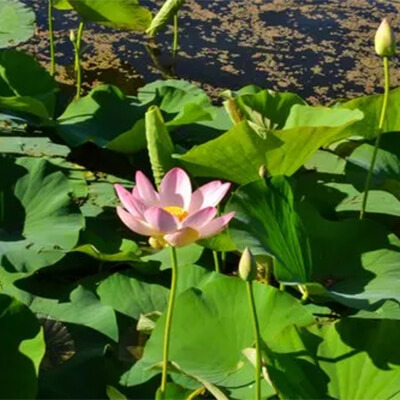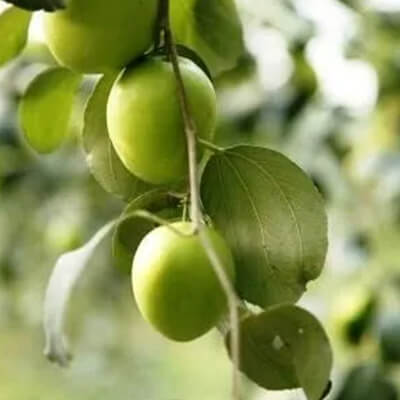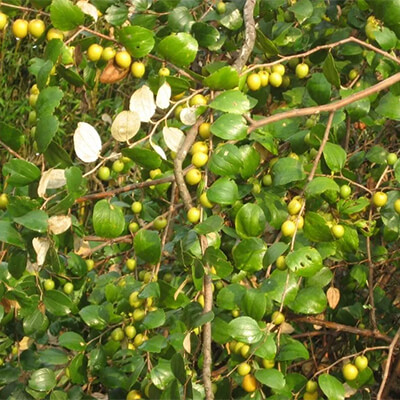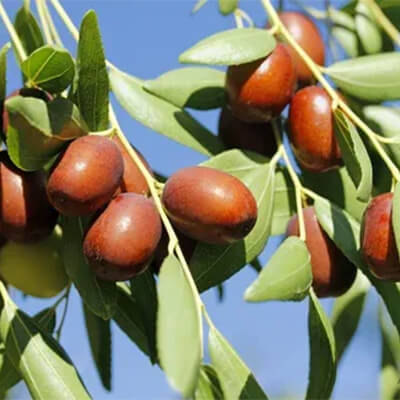On This Page
Indian Lotus, Kamal (Nelumbo Nucifera) – Uses and Benefits
Introduction
Indian lotus (Kamal) botanically known as Nelumbo nucifera is a national flower of India, which symbolizes fertility, divinity, knowledge, wealth, and enlightenment. It is also known as Sacred Lotus. Kamala is an aquatic plant that is famous for its fragrant, beautiful flower with numerous stamens and petals. This plant has great medicinal value as it is mentioned in almost all Samhita and Nighantus of Ayurveda. It is an edible plant for medicine and food both. Nelumbo nucifera contributes various pharmacological properties like a nootropic, anti-diabetic, anti-inflammatory, anti-diabetic, etc. Kamala is sweet, astringent, bitter with cold potency, and used in discoloration of urine, burning sensation, and for local application in skin ailments.
Basonym of Kamala
कं जलमलति भूषयति, अथवा कस्य जलस्य मालम विकारः जले जातत्वात, काम्यते श्रिया इति वल्लभगणि:।।
Kamala is an aquatic plant that enhances the beauty of the pond and is liked by the goddess Laxmi.
Synonyms of Kamala
Bhavprakash pushap Varga, 1-2 reference for Kamala synonyms:
वा पुंसि पद्मम नलिनं अरविन्दं महोत्पलम् ।
सहस्रपत्रं कमलं शतपत्रं कुशेशयम्।।
पङ्केरूह तामरसं सारसं सरसीरुहम्।
बिसप्रसूनाराजीव पुष्कराम्भोरूहाणि।।
Different Synonyms Interpretation:-
According to the Habitat of Kamala
- अम्भोरूहा-अम्भसि जले रोहति जायते इति ।
Kamala grows in the water body.
- कुशेशय – कुशे जले शेते इति ।
Many petals are present in the flower Kamala.
- सारस – सरसि भवं ।
Kamala is also found in lakes.
According to Morphology
- शतपत्रं – शतं पत्राणि दलान्यस्य ।
Kamala flowers have got a hundred petals.
- सहस्त्र पत्रं – सहस्त्रम पत्राणि दलान्यस्य ।
Many petals are present in the flowers of Kamla.
- राजीवं – राजते इतिः केसरस्य राजयस्यास्ति वा ।
Kamala flowers are having numerous stamens.
According to Properties and Action
- पुष्करम – पुष्णाति बीजानां विशेषतः पुष्टिकरत्वात ।
The seeds of Kamala are nutritious.
Some Other Synonyms of Kamala:-
- Pank Ruha: The root of the plant is embedded in the mud.
- Padam: Its flowers are beautiful.
- Nalina: The flower is fragrant.
- Tamra Rasa: Kamala is profuse with nectar.
- Bis Prasuna: Kamala grows from the rhizome.
Regional Name of Kamala
- Kamala (Hindi)
- Lotus (English)
- Tamara Puvvu (Telugu)
- Tamarai (Tamil)
- Tamara (Malayalam)
- Kamal (Marathi)
Botanical Name
Nelumbo nucifera Gaertn. Fruct.
Nelumbo word is derived from Nelumbium-Neeram which means water.
Nucifera word is derived from Nunci i.e nut, fera means bearing, Kamala has got the tough shelled seed.
Family
Nelumbonaceae
Ayurveda Reference for Kamala (Nelumbo nucifera)
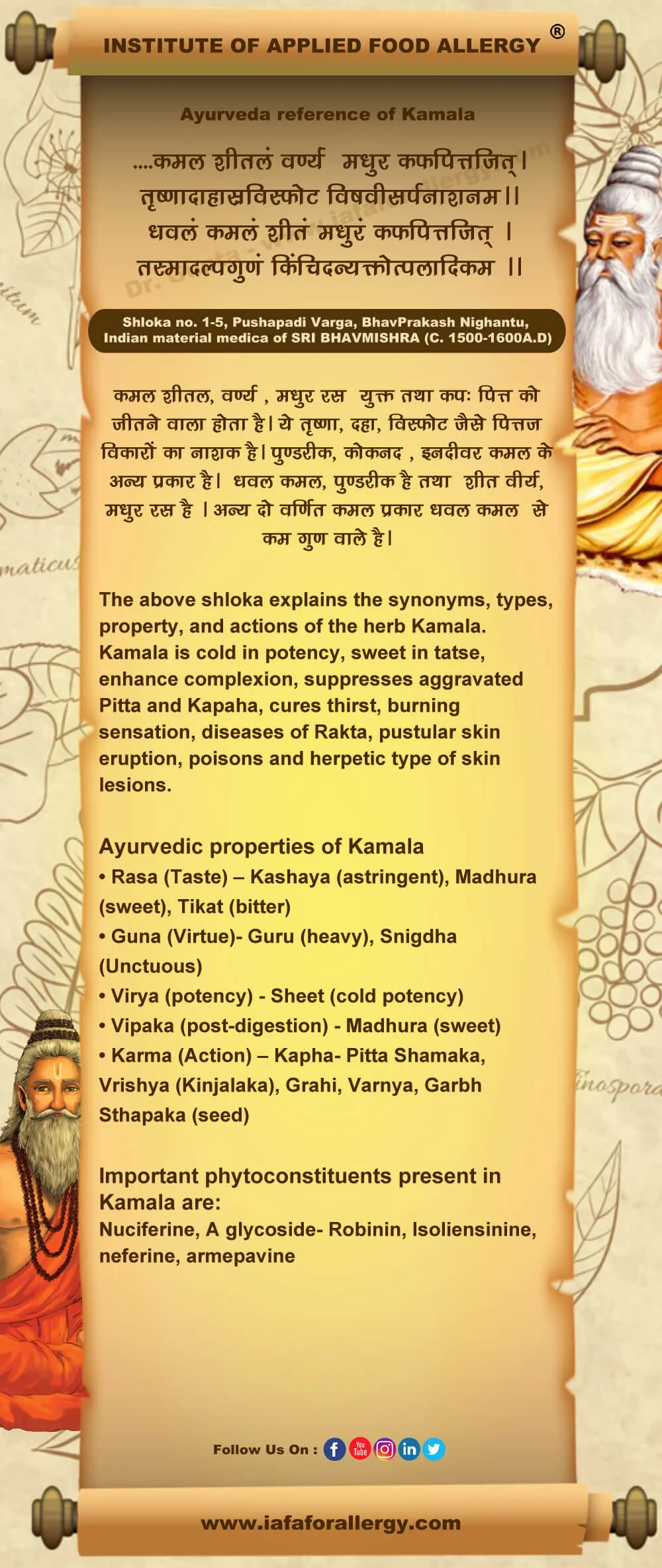
Scientific Classification of Kamala
| Kingdom | Plantae |
| Class | Dicotyledons |
| Subclass | Polypetalae |
| Series | Thalamiflorae |
| Order | Ranales |
| Family | Nelumbonaceae |
| Genus | Nelumbo |
| Species | Nucifera |
Classification of Kamala as per Charaka and Sushruta
- Charaka: Mutraviranjaniya Mahakshaya
- Sushruta: Utpaladi Gana, Pitta Shanshamana Varga
Kamala Description in Brihtrayi
| Charaka | Shusruta | Vagbhata (Ashtang Hridya) |
| C. S. Su. 3/ 23 | S. S. U. 64/ 14, 40 | A. H. Su. 3/ 35, 41 |
| C. S. Su. 5/ 19 | S. S. Su. 45/ 174 | A. H. Su. 15/ 38 |
| C. S. Chi. 4/ 73, 100, 101 | A. H. Ci. 20/ 38 | |
| C. S. Chi. 19/ 59 | A. H. Ci. 21/ 16 | |
| C. S. Chi. 22/ 36 | A. H. Sa. 2/ 3 | |
| C. S. Chi. 26/ 51 | A. H. Ci. 2/ 16 | |
| C. S. Si. 3/ 45, 48 | A. H. Ci. 8/ 128 | |
| A. H. Ci. 9/ 63 | ||
| A. H. Ka. 4/ 11 | ||
| A. H. U. 5/ 31 | ||
| A. H. U. 28/ 35 | ||
| A. H. U. 32/ 31 |
Kamala Description in Brihtrayi as the Name Given to its Different Parts, its Varieties, and its Synonyms
Shatpatra:
Charaka –
- C. S. SU 4/ 34
- C. S. Su. 25/ 49
- C. S. Vi. 6/ 16
- C. S. Ci. 3/ 257
- C. S. Si. 10/ 20
Ashtanga Hridya –
- A. H. U. 32/ 23
Vaarij:
Charaka – C. S. Ci. 4/ 106
Shaluka: It is the tuber obtained from the lotus
| Charaka | Sushruta | Vagbhata (Ashtang Hridya) |
| C. S. Su. 5/ 7 | S. S. Su. 46/ 463 | A. H. Su. 6/ 91 |
| C. S. Su. 27/ 114 | S. S. Chi. 37/ 30 | A. H. Su. 8/ 41 |
| C. S. Sa. 8/ 34 | S. S. Sa. 10/ 57 | A. H. Sa. 2/ 4 |
| C. S. Chi. 3/ 257 | S. S. U. 54/ 4 | |
| C. S. Chi. 14/ 10 | ||
| C. S. Chi. 17/ 14 | ||
| C. S. Chi. 21/ 74, 78, 82 | ||
| C. S. Chi. 26/ 75 | ||
| C. S. Chi. 30/ 88 |
Shvet Patra (A variety of Kamala): A. H. U. 5/ 33
Saroruha (Synonym of Kamala): A. H. Chi. 14/ 70
Mrinala: Mrinala is considered to be the leaf stalk of Kamala.
| Charaka | Sushruta | Vagbhata (Ashtang Hridya) |
| C. S. Vi. 6/ 16 | S. S. Su. 21/ 23 | A. H. Su. 3/ 35, 41 |
| C. S. Vi. 8/ 151 | S. S. Su. 46/ 298, 432, 463 | A. H. Su. 6/ 91 |
| C. S. Sa. 8/ 54 | S. S. Sa. 4/ 9 | A. H. Chi. 1/ 56 |
| C. S. Chi. 3/ 257 | S. S. Chi. 2/ 40 | A. H. Chi. 3/ 123 |
| C. S. Chi. 4/ 74, 93, 101 | S. S. Chi. 5/ 7, 8 | A. H. Chi. 7/ 105 |
| C. S. Chi. 12/ 66 | S. S. Chi. 11, 9 | A. H. Chi. 10/ 49 |
| C. S. Chi. 14/ 10 | S. S. Chi. 19/ 31 | A. H. Chi. 19/ 88 |
| C. S. Chi. 18/ 94 | S. S. Chi. 37/ 30 | A. H. U. 18/ 8 |
| C. S. Chi. 19/ 60 | S. S. U. 39/ 305 | A. H. U. 24/ 52 |
| C. S. Chi. 21/ 73, 74, 78, 83 | S. S. U. 40/ 64 | A. H. U. 37/ 86 |
| C. S. Chi. 26/ 167 | S. S. U. 45/ 40 | A. H. U. 39/ 48 |
| C. S. Si. 12/ 55 | S. S. U. 46/ 17 | |
| S. S. U. 58/ 58 |
Bisa and Bisa Granthi: Bisa is the leaf stalk and Bisa Granthi may be the rootstock of Kamala
| Charaka | Sushruta | Vagbhata (Ashtang Hridya) |
| C. S. Su. 5/ 7 | S. S. Su. 21/ 23 | A. H. Su. 7/ 30 |
| C. S. Su. 26/ 107 | S. S. Su. 45/ 17 | A. H. Su. 10/ 32 |
| C. S. Vi. 8/ 151 | S. S. Su. 46/ 298, 303, 463 | A. H. Sa. 3/ 46 |
| C. S. Chi. 3/ 257 | S. S. Chi. 5/ 7, 8 | A. H. Chi. 3/ 76, 104 |
| C. S. Chi. 11/ 18, 46 | S. S. Chi. 11/ 9 | A. H. Chi. 18/ 13 |
| C. S. Chi. 14/ 10 | S. S. Chi. 28/ 12 | A. H. U. 24/ 52 |
| C. S. Chi. 21/ 72, 78, 83 | S. S. Sa. 10/ 30, 62 | |
| C. S. Chi. 25/ 46 | S. S. U. 14/ 3 | |
| C. S. Chi. 26/ 76, 94, 168, 241 | S. S. U. 46/ 17 | |
| C. S. Chi. 29/ 132 | S. S. U. 47/ 41 | |
| C. S. Chi. 30/ 89 | S. S. U 48/ 23 | |
| C. S. Si. 12/ 55 | S. S. 54/ 4 |
Pushkar Beej (seed of Kamala):
Charaka-
- C. S. Su. 26/ 122
- C. S. Vi. 8/ 146
- C. S. Sa. 8/ 34
- C. S. Chi. 3/ 257
- C. S. Si. 12/ 54
Sushruta – S. S. Su. 42/ 18
Pankaja: Synonym: A. H. U. 39/ 104
Niraj: S. S. Chi. 25/ 33
Kokanada (a variety of Kamala) – C. S. Vi. 6/ 16
Arvind – C. S. Chi. 17/ 10, A. H. U. 39/ 48
Ambhoruha – S. S. Ka. 26/ 14
Amburuha – C. S. Chi. 22/ 36
Abja – S. S. U. 40/ 74, 50/ 24
External Morphology of Nelumbo Nucifera (Kamal)
Habit: A large aquatic herb.
Stem: Slender, elongate, branched, sending out roots at the nodes.
Leaves: Leaves of Nelumbo nucifera are Membranous, approximately 30 to 60 cm in diameter. Leaves are orbicular, concave, erect, peltate in shape, entire margins, radially nerved, and glaucous petioles are long. Rough with small distant prickles.
Flowers: Solitary, 10 to 25 cm in diameter, white or rosy, petals are 5 to 12 cm long, elliptic, obtuse, finely veined, concave.
Fruit: Ovoid and glabrous
Flowering and fruiting time
The flowering of Kamala occurs between July- October, also more or less throughout the year. Fruiting of Kamala occurs between April and June.
Distribution of Kamala
Globally it is distributed in Persia, Malaysia, China, Japan, and tropical Australia.
Nelumbo nucifera is found growing throughout the plains of India, in still water such as ponds, tanks, lakes (Kolleru lake in Andhra Pradesh), etc. The plant is often cultivated in warmer parts of India, particularly in ponds maintained at religious places.
The Useful Part of Kamala
Flower, seed, roots
Nutritional Value of Kamala (Root)
| Nutrients | Value/ 60g |
| Protein (g) | 0.95 g |
| Fat | 0.04 g |
| Fiber | 1.9 g |
| Sugar | 0.3 g |
| Iron | 0.54 mg |
| Vitamin B3 | 0.18 mg |
| Vitamin C | 16. 4 mg |
| Calcium | 16 mg |
| Magnesium | 13 mg |
| Phosphorus | 47 mg |
| Potassium | 218 mg |
| Sodium | 27 mg |
| Zinc | 0.2 mg |
Important Phytoconstituent of Kamala
- Leaves: The leaves contain alkaloids like Nuciferine, Asmilobine, Roemerine, and Nor-nuciferine.
- Flower: A glycoside- Robinin
- Root: Isoliensinine, neferine, armepavine (seeds)
- Plumule: The plumules yield proteins, sugars, and Vitamins.
- The receptacle contains Quercetin.
Recent Research on Kamala
- Hypotensive
- Diuretic
- Antifertility
- Antifungal
- Hypoglycemic
- Anticonvulsant
- Hemostatic
Rasa-Panchaka (Properties) of Kamala
| Rasa (Taste) | Kashaya (Astringent), Madhura (Sweet), Tikat (Bitter) |
| Guna (Virtue) | Guru (Heavy), Snigdha (Unctuous) |
| Virya (Potency) | Sheet (Cold Potency) |
| Vipaka (Post-Digestion) | Madhura (Sweet) |
| Karma (Action) | Kapha – Pitta Shamaka, Vrishya (Kinjalaka), Grahi, Varnya, Garbh Sthapaka (Seed) |
Prayogarha Vyadhi (Therapeutic Indication) of Kamala
Mutraviranjniya, Varnya, Rakat- Pitta, Daha, Visarp, Visa Roga, Trishna, Vaivarnya, Dourbalya, Klaibya, Mutra Vikara, Netra Roga
Aamyik Prayog (Therapeutic Uses) of Kamala
- Raktaja Arsha (Bleeding piles): Regular use of butter mixed with sugar and lotus stamens or sesamum, destroys bleeding piles. (Ashtang Hridya. Chi. 8/118)
- Raktaja Atisara (Diarrhea with blood): Goat’s milk processed with Kamala, Utpala, and Samanga (Lajjalu) or Mochrasa or sariva, Madhuka, and Lodhra or leaf-buds of Vata, etc. mixed with honey and sugar is used for drinking, eating and sprinkling anus. (Ashtang Hridya. Chi. 9/ 82-83)
- Madatya (Alcoholism): In case of alcoholism, one should take lotus stalk, Lotus-stem, Pippali, and Haritaki mixed with honey, or Duralabha or Musta with cold water. (Ashtang Hridya. Chi. 7/ 105)
- Jvara Atisara (Diarrhea with fever): Utpala, Dadima bark, and stamens of lotus-these taken together with rice water alleviate diarrhea associated with fever. (Bhav Prakash. Chi. 3/11)
- Guda Bhransha (Prolapse of the rectum): One who takes tender leaves of lotus plant mixed with sugar does not suffer from prolapse of the rectum. (Vrind Madhav. 57/24)
- Aantrik Raktstrava (Intrinsic hemorrhage):
- Water obtained for lotus ash and mixed with honey. (S. S. U. 45/ 35)
- Powdered lotus stamens mixed with sugar should be taken. It checks hemoptysis. (Harita Samhita.3.10.47)
- Duralabha, Parpata, and lotus stalk- these combined or separately pacify intrinsic hemorrhage. (Charaka Samhita. Chi. 4/75)
- Kasa (Cough): In a cough caused by pitta, one should use a powder of lotus seeds mixed with honey. It provides relief immediately. (Gada Nigreha. 2 .10. 35)
- Mutra Krichha (Dysuria):
- One should take the decoction of Kamala, Utpala, Sringataka, or Vidari, with cold water. (C. S. Chi. 26/ 51)
- Lotus root cooked in oil mixed with cow’s urine should be used in the retention of urine associated with severe pain. (Harita Samhita. 3. 30. 4)
- Akshi Roga (Eye disease): Cow’s milk alone cooked with lotus (and instilled in eyes) removes redness, hemorrhage, pain, wound, inflammation. (Vangsena Netra Adhikara. 200)
- Shishu Atisara (Children’s disease): Stamens of white lotus pounded with rice water and mixed with sugar candy checks dysentery immediately. (Vangsena, Bala. 48)
- Rasayana (Rejuvenator): Ghee processed with the paste of stalk stem, stamens, leaves, and the seed of lotus along with a piece of gold and milk is known as Pancharvinda (having five parts of lotus). It promotes strength, virility, and intellect. (AH.U.39.48)
- Garbha Patana (Abortion):
- One should take powder of blue lotus root and sugar mixed with honey and also sprinkle it with cold water. It is soothing and removes pain. (Gada Nigreha. 6. 3. 25)
- In abortion, leaves of lotus and blue lotus mixed with honey and sugar and taken with milk are useful in miscarriage and abortion. (Gada Nigreha. 6. 3. 18)
- (Dant Gata Vyadhi) Caries: In the case of caries of teeth, one should chew the root of the lotus. (Rajamrittanda. 5. 14)
Important Benefits of Kamal (Nelumbo Nucifera)
- Mood stabilizer or enhancer (Manoprasana): Due to the presence of pyridoxine which impacts mental state and mood by interacting with neural receptors in the brain helps to eradicate stress, irritability, etc.
- Anemia (Pandu): Due to the presence of iron and copper in meaningful amounts, it helps in the production of RBC and hence helps in treating anemia.
- Constipation (Vivandh): Lotus adds bulk to the stool and eases bowel movement as it is loaded with dietary fibers.
- Obesity (Stholya): As the lotus is less in calories and full of various nutrients, it makes it full for a longer time. Lowers the chances of overeating and thus, helps in the management of weight.
- Lotus is rich in vitamin A, therefore very beneficial for hairs, skin, eyes, etc.
Matra (Therapeutic Administration and Dosage) of Kamal (Nelumbo Nucifera)
- Beej Churna (Seed Powder) – 3 to 6 grams
- Dala Hima (Cold Infusion) – 10 to 20 ml
- Decoction (Kwath) – 50- 100 ml
- Phala (Fruit) – 10- 20 gram

Have A Health Issue?
Consult Online
- Dr. Sahil Gupta (B.A.M.S., M.H.A.)
Ayurvedic Allergy Specialist
CEO & Founder of IAFA®
Classical Reference of Kamala
Dhanvantri Nighantu
Padam (Karviraadi Varga. 139)
पद्मनी शिशिरा रूक्षा कफपित्तहरा समृता।
Padam Beeja (Karveeradi varga. 141)
स्वादु तिक्तं पद्मबीजं गर्भस्थापनमुत्तमम् ।
रक्तपित्तप्रशमनं किंचिन मारुतकृद भवेत् ।
Mrinala (Karveeradi Varga. 143)
अविदाहि बिसं प्रोक्तं रक्तपित्तप्रसादनम ।
विष्टम्भि मधुर रुक्षं दर्जर वात कोपनं।।
Padam Kanda (Karveeradi Varga. 145)
पद्मकन्द: कषायः स्यात तिक्तः स्वादु विपाक्त: ।
शीत वीर्यो अस्रपित्तोतथरोगभंगाय कल्पते।।
Padam Kesar (Karveeradi Varga. 147)
तृषाघ्नम शीतलम रक्ष्म पित्तरक्त क्षयापहम।
पद्मकेशरमेवक्तम पित्तघ्नं च कषायकम।।
Kaidev Nighantu, Aushadhiadi Varga, 1445-1446
कमल शीतलं तिक्तं कषायं स्वादु वर्णकृत।
कफपित्तास्त्र विस्फोट दहा तृष्णा विनाशनं।।
Raj Nighantu
Kamala (Karveeradi Varga, 175)
कमलं शीतलं स्वादु रक्तपित्तश्रमार्तिनुत ।
सुगन्धि भ्रान्तिसन्तापशान्तिद तर्पणं परम ।।
Pundarika (Karveeradi Varga, 177)
पुण्डरीकं हिमं तिक्तं मधुर पित्तनाशनम् ।
दाहास्रश्रमदोषघ्न पिपासादोषनाशनम् ।।
Kokanada: Rakata Kamala (Karveeradi Varga, 179)
कोकनदं कटु तिक्तं मधुरं शिशिरं च रक्तदोषहरम् ।
पित्तकफवातशमनं सन्तर्पणकारण वृष्यम् ।।
Nila Kamala (Karveeradi Varga, 181)
नीलाब्ज शीतलं स्वादु सुगन्धि पित्तनाशकृत् ।
रूच्यं रसायने श्रेष्ठ्म केश्यच्च देह दाढरिद्म।।
Bhava Prakash Nighantu, Pushapa Varga, 9- 13
संवर्तिका हिमा तिक्ता कषाया दाहतृट्प्रणुत् ।
मूत्रकृच्छगुदव्याधिरक्तपित्तविनाशिनी।।
Karnika (Bija Kosha) of Kamala
पद्मस्य कर्णिका तिक्ता कषाया मधुरा हिमा।
मुख वैशद्य कृल्लध्वी तृष्णास्रकफपित्तनुत् पूर्ण।।
Kinjalaka (Kesar) of Kamala
किञ्जल्क: शीतलो वृष्यः कषायो ग्राहकोपिस।
कफपित्ततृषादाह रक्ताशोविषशोथजित्॥
Mrinal (Kamala Naal) & Shaaluk (Kamala Kanda) of Kamala
मृणाल शीतलं वृष्यं पित्तदाहास्जिद गुरु ।
दुर्जरम स्वादुपाकच्च स्तन्यानिलकफप्रदं।।
संग्राहि मधुरं रुक्षं शालूकमपितदगुणम्।।
Priya Nighantu, Shatpushpadi Varga, 81 -82)
पद्मपुष्पं हिमं स्वादु कषायं कफपित्तजित् ।
तृष्णादाहास्रविस्फोटविषवीसर्पनाशनम् ।।
पद्मबीजं तु तद्वत स्याद् विशेषाद गर्भदं परम् ।
बल्य वृष्यश्च विष्टम्भि रक्तपित्तप्रसादनम्।।
Varieties of Kamala
Bhava Prakash Pushapa Varga. 4
विशेषत: सितम पद्मम पुण्डरीकमिति स्मृतम् ।
रक्तं कोकनदं नीलमिन्दीवरं स्मृतम।।
Raj Nighantu, Karveeradi varga, 182
इषत् श्वेतम पद्मं नलिनं च तदुक्तमीषादारक्तम।
उत्पलमीषन्नीलं त्रिविधमितोदं भवेत् कमलम् ।।
Specific Formulation of Kamala
- Arvinda Aasava (indicated for Bala roga)
- Utpaladi Churna (indicated for Rakta Pradra i.e menorrhagia, Yonishool i.e vaginal pain)
- Madhukadya Avleha (indicated in Pradara i.e leucorrhea, Daha i.e burning sensation)
Varieties of Kamala in Bhava Prakash Nighantu
- Shweta (Padma, Pundarika)
- Rakta (Kokanada)
- Nila (Indivira)
Dhanwantri has Mentioned 6 Types of kamala
- Pundarika
- Saugandhika
- Rakatpadma
- Kumuda
- Kshudrotpala
- Padmini
Different Types of Kamala in Charaka Ukata Mutra Viranjniya Mahakshaya
- Padma
- Utpala
- Nalini
- Kumuda
- Saugandhika
- Pundarika
- Shatpatra
Contraindication and Side Effects of Kamal (Nelumbo Nucifera)
- If you are pregnant or breastfeeding, stay on the safe side and avoid the use of Lotus.
- A diabetic patient must monitor their sugar if they are taking lotus as medicine because it may lower their blood glucose level.
- Pentobarbital interacts with Lotus and might cause too much drowsiness.
Suggestive Readings Regarding Kamala
- Lin Z, Zhang C, Cao D, Damaris RN, Yang P. The Latest Studies on Lotus (Nelumbo nucifera)-an Emerging Horticultural Model Plant. Int J Mol Sci. 2019;20(15):3680. Published 2019 Jul 27. doi:10.3390/ijms20153680
- Buddhadev, Sheetal & Buddhadev, Sandip. (2014). Nelumbo nucifera the phytochemical profile and traditional uses. Pharma Sci. Monit.. 5. 1-12.
- Mukherjee, Pulok & Mukherjee, Debajyoti & Maji, Amal & Rai, S & Heinrich, Michael. (2009). The sacred lotus (Nelumbo nucifera) – Phytochemical and therapeutic profile. The Journal of pharmacy and pharmacology. 61. 407-22. 10.1211/jpp/61.04.0001.
- Temviriyanukul, Piya et al. “The Effect of Sacred Lotus (Nelumbo nucifera) and Its Mixtures on Phenolic Profiles, Antioxidant Activities, and Inhibitions of the Key Enzymes Relevant to Alzheimer’s Disease.” Molecules (Basel, Switzerland) vol.25,163713. 14 Aug. 2020, doi:10.3390/molecules25163713
- https://doi.org/10.1155/2015/789124
- https://sciencejournals.stmjournals.in/index.php/RRJoAST/article/view/2998
References
- Agnivesha, Charaka, Dridhabala . In: Charaka Samhita, ed. Vaidya Jadavaji Trikamji Aacharya., editor. Varanasi: Chaukhamba Sanskrit Sansthan; 2009.
- Sushruta. In: Sushruta Samhita, Sutra Sthana, ed. Vaidya Jadavji Trikamji Acharya., editor. Varanasi: Choukhambha Orientalia; 2005.
- Vagbhata. In: Ashtanga Hrudaya, 9th ed. Anna Moreshwar Kunte, Krishnashastri Navarre, Harishastri, editors. Varanasi: Choukhambha Orientalia; 2005.
- Bhavamishra. In: BhavaPrakasha Nighantu, 11th ed. part 2. Brahma Shankara Mishra., editor. Varanasi: Choukhambha Bharati Academy; 2009.
- Bhavprakasha, commentary by Bulusu Sitaram, forwarded by K.C.Chunekar
- Dhanvantari Nighantu, Diwedi BK. Editor. Guduchyadi varga, Chaukhamba Krishnadas Academy, Varanasi; 2008.
- Sharma PV, Kaideva Nighantu. Aushadhi Varga. Chaukhamba Orientalia, Varanasi; 2006:
- Tripathi I., Raja Nighantu, Guduchyadi varga, Chaukhamba Krishnadas Academy; Varanasi; 2010
- Dr. Gyanendra Pandey, Dravyaguna Vigyana, reprint 2012, Chwkhamba Krishnadas Academy
- K.niteshwar Dravyagunavigyana, reprint 2017.
- Dr. J.L.N. Sastry and Dr. B.S. Sastry, Dravyaguna Vigyana, Chaukhambha Orientalia, Varanasi.
- Chakrapanidatta, chakradatta with the vaidayaprabhahindi commentary by indradevatripathi, chaukambha sankritasansthan, varanai 2nd Edition, 1994.
- https://doi.org/10.1155/2015/789124
- https://sciencejournals.stmjournals.in/index.php/RRJoAST/article/view/2998
- The Latest Studies on Lotus (Nelumbo nucifera)-an Emerging Horticultural Model Plant
- https://www.healthline.com/health/8-uses-for-lotus
Ayurveda is an Indian system of medicine that is popular since ancient times. Dr. Gupta’s IAFA® has been conducting research studies to find out different phytoconstituents of herbs and their action in the body. Such knowledge acquired by our experts is used in the preparation of medicines and providing the treatment facilities safely and effectively. IAFA® is the provider of safe and effective treatment for a wide range of diseases, mainly allergic diseases all based on Ayurveda.
Was this Page Helpful?
Read More Articles

Souvira / Raja Badara (Zizyphus Sativa, Ziziphus Xylopyrus, Zizyphus Vulgaris) – Part – 2
Souvira or Raja Badara botanically known as Zizyphus vulgaris or Zizyphus xylopyra is a deciduous tree…

Karkandhu / Kshudra Badara (Zizyphus Nummularia) – Part – 3
Karkandhu or Z. nummularia is a type of Badara that is commonly…

Badara / Kola (Ziziphus Jujuba, Ziziphus Mauritiana) – Part – 1
Badara is wildly and cultivated found in India and it is a…

